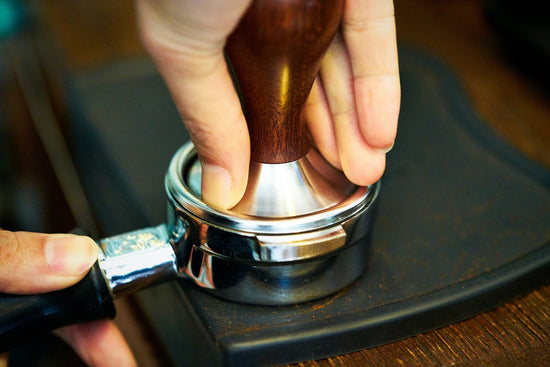Coffee Scales: Precision Brewing for the Perfect Cup
Precision is essential when it comes to brewing the perfect cup of coffee. Enthusiasts and professionals alike know that consistency in measurement is crucial, and that's where coffee scales come into play. By accurately measuring the weight of your coffee beans and water, you can ensure a balanced and consistent brew every time. But achieving coffee nirvana doesn't stop at the right amount of beans and water. Your coffee equipment must be in top condition, and regular cleaning and maintenance are essential. This blog delves into the importance of maintaining your coffee gear, the essential tools for cleaning, reviews of effective cleaning products, and a step-by-step guide to keeping your coffee makers in pristine condition.

The Importance of Accurate Measurement
Using a coffee scale to measure the weight of your coffee beans and water is fundamental to achieving a perfect brew. Here’s why precision is so important:
- Consistency : When you measure your coffee and water by weight, you ensure that each cup you brew has the same strength and flavour. This consistency is essential, especially if you have found a particular ratio that works best for your taste.
- Control : Weighing your ingredients gives you greater control over the brewing process. It allows you to make precise adjustments to the coffee-to-water ratio, leading to a more tailored and refined flavour profile.
- Brew Ratio : The coffee-to-water ratio is crucial in determining the strength and flavour of your coffee. Too much coffee can make it overly strong and bitter, while too little can result in a weak and underwhelming brew. A coffee scale helps you get this balance just right.
- Efficiency : Measuring by weight is more accurate than using volume-based measurements, such as scoops or tablespoons, which can vary significantly. This accuracy helps you use your coffee beans more efficiently, avoiding wastage and ensuring you get the most out of your beans.
Precision Brewing and How It Affects Your Coffee
Precision brewing is all about controlling every variable in the coffee-making process to achieve the best possible cup. Here's how it affects your coffee:
Exact Coffee-to-Water Ratio
Using a coffee scale allows you to measure your coffee and water with precision, ensuring you achieve the exact ratio needed for your preferred strength and flavour. The commonly recommended ratio is 1:15 (one gram of coffee to 15 grams of water) for a balanced cup, but this can be adjusted to taste. Precision in this ratio helps you avoid over-extraction (which can make coffee bitter) and under-extraction (which can make it sour or weak).

Consistency in Every Brew
Consistency is key to making great coffee every time. By using a scale, you can replicate the exact measurements for each brew, ensuring that every cup you make tastes just as good as the last one. This consistency is particularly important for those who enjoy exploring different beans and roasts, as it allows you to appreciate the subtle differences in flavour profiles.

Better Control Over Brewing Variables
Coffee brewing involves various variables, including grind size, water temperature, brewing time, and agitation. Using a scale helps you control one of the most critical variables: the coffee-to-water ratio. With this precise control, you can fine-tune other aspects of your brewing process to suit your taste preferences and the characteristics of the coffee beans you are using.

Enhanced Flavour Profiles
Precision in measuring your ingredients leads to better extraction, which in turn enhances the flavour profile of your coffee. You can highlight the unique notes and nuances of different coffee beans, whether they are fruity, floral, nutty, or chocolatey. Precision brewing allows you to experience coffee as it was intended by the roaster, bringing out the best in each bean.
Experimentation and Customisation
For those who enjoy experimenting with their coffee, a scale provides a reliable foundation for testing different brewing methods, ratios, and recipes. You can easily adjust the amount of coffee and water to find your perfect brew. This level of customisation is particularly useful for coffee enthusiasts who like to explore various brewing techniques such as pour-over, Aeropress, French press, and espresso.

The Importance of Regular Cleaning and Maintenance
Regular cleaning and maintenance of your coffee equipment are not just about hygiene; they directly impact the taste and quality of your brew. Over time, coffee oils and residue build up in your equipment, leading to bitter flavours and potentially clogging the machinery. Here are a few reasons why you should make cleaning a routine part of your coffee-making process:
- Preserve Flavour : Coffee oils and residues can go rancid, imparting off-flavours to your coffee. Regular cleaning ensures each cup tastes as fresh as possible.
- Extend Lifespan : Proper maintenance reduces wear and tear, prolonging the life of your equipment.
- Efficiency : Clean machines operate more efficiently, maintaining consistent temperature and pressure, crucial for a good extraction.
- Health and Safety : Coffee machines can harbour bacteria and mould if not cleaned regularly, posing health risks.

Essential Cleaning Tools for Coffee Equipment
To keep your coffee equipment in top shape, you'll need a few essential cleaning tools. Each tool plays a specific role in maintaining cleanliness and ensuring the longevity of your coffee gear.
Brushes : Specialised brushes for coffee machines are designed to reach into all the nooks and crannies where coffee grounds and oils can accumulate. There are various types:
- Group Head Brushes : For espresso machines, these brushes clean the group head where the portafilter locks in.
- Grinder Brushes : These help remove residual coffee grounds from your grinder, ensuring it runs smoothly.
- Milk Frother Brushes : Designed to clean the steam wand and milk frothing accessories.
Cleaning Solutions : These are formulated to break down coffee oils and residues that plain water can't remove.
- Espresso Machine Cleaner : A powder or tablet used for backflushing the machine.
- Grinder Cleaning Pellets : These remove oils and residues from the burrs.
- Milk System Cleaner : Specifically for cleaning steam wands and milk frothers.
Descaling Products : Hard water can cause mineral buildup in your coffee machine, affecting performance and taste. Descaling solutions dissolve these deposits.
- Liquid Descalers : Easy to use and highly effective for espresso machines, drip coffee makers, and kettles.
- Descaling Tablets : Convenient and pre-measured, these tablets are ideal for those who want a hassle-free descaling process.
Microfibre Cloths : These are perfect for wiping down surfaces and removing any residue without scratching the equipment.
Cleaning Pins and Needles : Essential for unclogging small parts of your coffee machine, such as the steam wand or espresso machine nozzles.
"I love coffee like bears love honey"
Reviews of Effective Cleaning Products
With so many cleaning products on the market, it can be challenging to choose the best ones for your coffee equipment. Here are reviews of some highly effective products:
Urnex Cafiza Espresso Machine Cleaner
This product is a favourite among baristas for its powerful cleaning ability. It efficiently removes coffee oils, grounds, and residues from espresso machines. Cafiza is available in powder and tablet form, making it versatile for different cleaning needs.
Pros :
- Highly effective in removing stubborn coffee oils
- Suitable for both home and commercial use
- Available in multiple forms (powder and tablets)
Cons :
- Requires thorough rinsing to remove all residues
Grindz Grinder Cleaner
From the same company, Urnex, the Grindz Grinder Cleaner is an excellent product for maintaining your coffee grinder. The food-safe, biodegradable pellets effectively remove coffee particles and oils from the burrs without disassembling the grinder.
Pros :
- Easy to use and efficient
- No need to disassemble the grinder
- Non-toxic and biodegradable
Cons :
- Slightly expensive compared to other methods
- May leave some residue if not properly run through
Dezcal is a powerful descaling solution that works on various coffee machines, kettles, and even boilers. It's highly effective at dissolving mineral buildup, ensuring your machine operates at peak performance.
Pros :
- Extremely effective against mineral deposits
- Easy to use with clear instructions
- Versatile for different types of equipment
Cons :
- Strong chemical smell during use
- Needs to be handled with care
Rinza by Urnex is specifically designed for cleaning milk frothers and steam wands. It breaks down milk residues that can clog the frothing system and affect the taste of your drinks.
Pros :
- Efficiently cleans milk residues
- Easy to use with detailed instructions
- Safe for all types of milk systems
Cons :
- Requires regular use for best results
- Needs thorough rinsing to remove any chemical taste
Step-by-Step Cleaning Guide for Various Coffee Makers
Keeping your coffee equipment in pristine condition requires regular cleaning. Here's a step-by-step guide for different types of coffee maker
Espresso Machines
Daily Cleaning:
- Backflush : Use a blind filter and add a recommended amount of espresso machine cleaner. Run the machine for a few cycles to clean the group head.
- Clean Portafilter and Basket : Remove the portafilter, take out the basket, and clean them with hot, soapy water. Rinse thoroughly.
-
Wipe Down : Use a damp microfibre cloth to wipe down the exterior of the machine and the steam wand.
Weekly Cleaning:
- Descale : Follow the manufacturer’s instructions to descale your machine using a liquid descaler.
- Deep Clean Group Head : Use a group head brush to scrub the group head and gasket thoroughly.
- Clean Drip Tray and Water Tank : Remove these parts and wash them with warm, soapy water. Rinse and dry before reinserting.
Monthly Cleaning:
- Deep Clean Grinder : Use grinder cleaning pellets to remove coffee oils and residues from the burrs.
- Inspect and Replace Parts : Check gaskets, seals, and other parts for wear and tear, and replace them if necessary.

Drip Coffee Makers
Daily Cleaning:
- Empty and Rinse Carafe : After each use, rinse the carafe and filter basket with warm water.
- Wipe Down : Use a damp cloth to clean the exterior of the machine and the warming plate.
Weekly Cleaning:
- Deep Clean Carafe and Basket : Wash the carafe and filter basket with hot, soapy water. Use a brush to scrub any stubborn stains.
- Descale : Run a descaling solution through a brew cycle. Follow with at least two cycles of clean water to rinse.
Monthly Cleaning:
- Clean Water Reservoir : Use a mixture of vinegar and water to clean the reservoir, then rinse thoroughly with clean water.
- Inspect and Clean Spray Head : If your machine has a removable spray head, take it out and clean it to remove any buildup.

French Press
After Each Use:
- Disassemble : Take apart the plunger, lid, and filter screen.
- Rinse and Scrub : Rinse all parts under warm water. Use a small brush to scrub the filter screen and plunger.
- Wash : Wash all parts with hot, soapy water, then rinse and dry thoroughly.
Monthly Cleaning:
- Deep Clean : Soak the parts in a mixture of baking soda and warm water for an hour. Scrub with a brush, rinse, and dry.

Tips for Keeping Your Gear in Pristine Condition
- Consistency is Key : Clean your equipment regularly rather than waiting for buildup to occur. This ensures better performance and longevity.
- Use the Right Tools : Invest in good quality cleaning tools and products specifically designed for coffee equipment.
- Follow Manufacturer Instructions : Always adhere to the guidelines provided by the equipment manufacturer for cleaning and maintenance.
- Rinse Thoroughly : After using any cleaning solution, ensure you rinse your equipment thoroughly to avoid any chemical residues affecting the taste of your coffee.
- Store Properly : When not in use, store your equipment in a dry, clean place to avoid any contamination or damage.
Conclusion
Achieving the perfect cup of coffee is an art that combines precision, quality ingredients, and well-maintained equipment. Regular cleaning and maintenance are non-negotiable steps in this process. By using the right tools and cleaning products, you ensure that your coffee equipment stays in excellent condition, delivering the best possible flavour with every brew. Embrace these practices, and you'll not only extend the life of your coffee gear but also elevate your coffee experience to new heights. Happy brewing!
Frequently Asked Questions
1. Why is it important to clean my coffee equipment regularly?
- Regular cleaning of your coffee equipment is crucial for several reasons. It helps preserve the flavour of your coffee by removing old oils and residues that can impart a bitter taste. Additionally, it extends the lifespan of your equipment by preventing build-up that can cause wear and tear. Clean equipment also operates more efficiently, ensuring consistent performance, and it helps maintain hygiene by preventing the growth of bacteria and mould.
2. What cleaning tools do I need for my coffee equipment?
- Essential cleaning tools for your coffee equipment include:
- Brushes : For cleaning group heads, grinders, and milk frothers.
- Cleaning Solutions : Specialised cleaners for espresso machines, grinders, and milk systems.
- Descaling Products : Liquid descalers or tablets to remove mineral buildup.
- Microfibre Cloths : For wiping down surfaces without scratching.
- Cleaning Pins and Needles : For unclogging small parts like steam wands and nozzles.
3. How often should I clean my espresso machine?
You should perform a basic cleaning daily, including backflushing the machine, cleaning the portafilter and basket, and wiping down the exterior. Weekly, you should descale the machine and deep clean the group head, drip tray, and water tank. Monthly, use grinder cleaning pellets and inspect and replace any worn-out parts.
4. What’s the best way to descale my coffee maker?
To descale your coffee maker, follow these steps:
- Fill the water reservoir with a descaling solution or a mixture of vinegar and water.
- Run a brew cycle to allow the solution to pass through the system.
- Rinse the machine by running at least two cycles of clean water to remove any residue.Always follow the manufacturer’s instructions for specific descaling products and procedures.
Products Featured In This Blog



